A numerically efficient globally averaged number density approach is used to simulate a reaction-diffusion system using a particle-based stochastic simulation algorithm called reactive multiparticle collision (RMPC) dynamics. Constant diffusivity of the particles is achieved through a time-varying rotation angle (also called collision angle). Variation in the diffusion coefficient between two different chemical species is achieved in one of two ways: (ⅰ) using a different kBT/m value for one species compared to the other, or (ⅱ) using the same kBT/m value for both species, but using a different probability to free-stream for one species compared to another. For smaller diffusivities and larger spatial inhomogeneities, bath particles were necessary for the model to agree with the PDE solution. The latter approach was further used without a bath, and shown to be capable of producing Turing patterns after long simulation times. The significance of our work is that RMPC can serve as a feasible simulation tool for both short and long-term simulations, can handle spatial inhomogeneities, can model a fairly large range of diffusivities in a reaction-diffusion scenario, and is capable of producing Turing patterns. An advantage of this method includes more detailed system information in feasible simulation times.
1.
Introduction
Segre [1] made a pioneering attempt in the development of special algebra. He conceptualized the commutative generalization of complex numbers, bicomplex numbers, tricomplex numbers, etc. as elements of an infinite set of algebras. Subsequently, in the 1930s, researchers contributed in this area [2,3,4]. The next fifty years failed to witness any advancement in this field. Later, Price [5] developed the bicomplex algebra and function theory. Recent works in this subject [6,7] find some significant applications in different fields of mathematical sciences as well as other branches of science and technology. An impressive body of work has been developed by a number of researchers. Among these works, an important work on elementary functions of bicomplex numbers has been done by Luna-Elizaarrarˊas et al. [8]. Choi et al. [9] proved some common fixed point theorems in connection with two weakly compatible mappings in bicomplex valued metric spaces. Jebril [10] proved some common fixed point theorems under rational contractions for a pair of mappings in bicomplex valued metric spaces. In 2017, Dhivya and Marudai [11] introduced the concept of a complex partial metric space, suggested a plan to expand the results and proved some common fixed point theorems under a rational expression contraction condition. In 2019, Mani and Mishra [12] proved coupled fixed point theorems on a complex partial metric space using different types of contractive conditions. In 2021, Gunaseelan et al. [13] proved common fixed point theorems on a complex partial metric space. In 2021, Beg et al.[14] proved fixed point theorems on a bicomplex valued metric space. In 2021, Zhaohui et al. [15] proved common fixed theorems on a bicomplex partial metric space. In this paper, we prove coupled fixed point theorems on a bicomplex partial metric space. An example is provided to verify the effectiveness and applicability of our main results. An application of these results to Fredholm integral equations and nonlinear integral equations is given.
2.
Preliminaries
Throughout this paper, we denote the set of real, complex and bicomplex numbers, respectively, as C0, C1 and C2. Segre [1] defined the complex number as follows:
where ϑ1,ϑ2∈C0, i21=−1. We denote the set ofcomplex numbers C1 as:
Let z∈C1; then, |z|=(ϑ21+ϑ22)12. The norm ||.|| of an element in C1 is the positive real valued function ||.||:C1→C+0 defined by
Segre [1] defined the bicomplex number as follows:
where ϑ1,ϑ2,ϑ3,ϑ4∈C0, and independent units i1,i2 are such that i21=i22=−1 and i1i2=i2i1. We denote the set of bicomplex numbers C2 as:
i.e.,
where z1=ϑ1+ϑ2i1∈C1 and z2=ϑ3+ϑ4i1∈C1. If ς=z1+i2z2 and η=ω1+i2ω2 are any two bicomplex numbers, then the sum is ς±η=(z1+i2z2)±(ω1+i2ω2)=z1±ω1+i2(z2±ω2), and the product is ς.η=(z1+i2z2)(ω1+i2ω2)=(z1ω1−z2ω2)+i2(z1ω2+z2ω1).
There are four idempotent elements in C2: They are 0,1,e1=1+i1i22,e2=1−i1i22 of which e1 and e2 are nontrivial, such that e1+e2=1 and e1e2=0. Every bicomplex number z1+i2z2 can be uniquely expressed as the combination of e1 and e2, namely
This representation of ς is known as the idempotent representation of a bicomplex number, and the complex coefficients ς1=(z1−i1z2) and ς2=(z1+i1z2) are known as the idempotent components of the bicomplex number ς.
An element ς=z1+i2z2∈C2 is said to be invertible if there exists another element η in C2 such that ςη=1, and η is said to be inverse (multiplicative) of ς. Consequently, ς is said to be the inverse(multiplicative) of η. An element which has an inverse in C2 is said to be a non-singular element of C2, and an element which does not have an inverse in C2 is said to be a singular element of C2.
An element ς=z1+i2z2∈C2 is non-singular if and only if ||z21+z22||≠0 and singular if and only if ||z21+z22||=0. When it exists, the inverse of ς is as follows.
Zero is the only element in C0 which does not have a multiplicative inverse, and in C1, 0=0+i10 is the only element which does not have a multiplicative inverse. We denote the set of singular elements of C0 and C1 by O0 and O1, respectively. However, there is more than one element in C2 which does not have a multiplicative inverse: for example, e1 and e2. We denote this set by O2, and clearly O0={0}=O1⊂O2.
A bicomplex number ς=ϑ1+ϑ2i1+ϑ3i2+ϑ4i1i2∈C2 is said to be degenerated (or singular) if the matrix
is degenerated (or singular). The norm ||.|| of an element in C2 is the positive real valued function ||.||:C2→C+0 defined by
where ς=ϑ1+ϑ2i1+ϑ3i2+ϑ4i1i2=z1+i2z2∈C2.
The linear space C2 with respect to a defined norm is a normed linear space, and C2 is complete. Therefore, C2 is a Banach space. If ς,η∈C2, then ||ςη||≤√2||ς||||η|| holds instead of ||ςη||≤||ς||||η||, and therefore C2 is not a Banach algebra. For any two bicomplex numbers ς,η∈C2, we can verify the following:
1. ς⪯i2η⟺||ς||≤||η||,
2. ||ς+η||≤||ς||+||η||,
3. ||ϑς||=|ϑ|||ς||, where ϑ is a real number,
4. ||ςη||≤√2||ς||||η||, and the equality holds only when at least one of ς and η is degenerated,
5. ||ς−1||=||ς||−1 if ς is a degenerated bicomplex number with 0≺ς,
6. ||ςη||=||ς||||η||, if η is a degenerated bicomplex number.
The partial order relation ⪯i2 on C2 is defined as follows. Let C2 be the set of bicomplex numbers and ς=z1+i2z2, η=ω1+i2ω2∈C2. Then, ς⪯i2η if and only if z1⪯ω1 and z2⪯ω2, i.e., ς⪯i2η if one of the following conditions is satisfied:
1. z1=ω1, z2=ω2,
2. z1≺ω1, z2=ω2,
3. z1=ω1, z2≺ω2,
4. z1≺ω1, z2≺ω2.
In particular, we can write ς⋦i2η if ς⪯i2η and ς≠η, i.e., one of 2, 3 and 4 is satisfied, and we will write ς≺i2η if only 4 is satisfied.
Now, let us recall some basic concepts and notations, which will be used in the sequel.
Definition 2.1. [15] A bicomplex partial metric on a non-void set U is a function ρbcpms:U×U→C+2, where C+2={ς:ς=ϑ1+ϑ2i1+ϑ3i2+ϑ4i1i2,ϑ1,ϑ2,ϑ3,ϑ4∈C+0} and C+0={ϑ1∈C0|ϑ1≥0} such that for all φ,ζ,z∈U:
1. 0⪯i2ρbcpms(φ,φ)⪯i2ρbcpms(φ,ζ) (small self-distances),
2. ρbcpms(φ,ζ)=ρbcpms(ζ,φ) (symmetry),
3. ρbcpms(φ,φ)=ρbcpms(φ,ζ)=ρbcpms(ζ,ζ) if and only if φ=ζ (equality),
4. ρbcpms(φ,ζ)⪯i2ρbcpms(φ,z)+ρbcpms(z,ζ)−ρbcpms(z,z) (triangularity) .
A bicomplex partial metric space is a pair (U,ρbcpms) such that U is a non-void set and ρbcpms is a bicomplex partial metric on U.
Example 2.2. Let U=[0,∞) be endowed with bicomplex partial metric space ρbcpms:U×U→C+2 with ρbcpms(φ,ζ)=max, where e^{i_{2}\theta} = \cos \theta +i_{2}\sin \theta , for all \varphi, \zeta\in \mathcal{U} and 0\leq \theta\leq \frac{\pi}{2} . Obviously, (\mathcal{U}, \rho_{bcpms}) is a bicomplex partial metric space.
Definition 2.3. [15] A bicomplex partial metric space \mathcal{U} is said to be a T_{0} space if for any pair of distinct points of \mathcal{U} , there exists at least one open set which contains one of them but not the other.
Theorem 2.4. [15] Let (\mathcal{U}, \rho_{bcpms}) be a bicomplex partial metric space; then, (\mathcal{U}, \rho_{bcpms}) is T_{0} .
Definition 2.5. [15] Let (\mathcal{U}, \rho_{bcpms}) be a bicomplex partial metric space. A sequence \{\varphi_{\tau}\} in \mathcal{U} is said to be convergent and converges to \varphi\in\mathcal{U} if for every 0\prec_{i_{2}}\epsilon\in \mathscr{C}^{+}_{2} there exists \mathcal{N}\in \mathbb{N} such that \varphi_{\tau}\in \mathfrak{B}_{ \rho_{bcpms}}(\varphi, \epsilon) = \{\omega\in \mathcal{U}:\rho_{bcpms}(\varphi, \omega) < \epsilon+\rho_{bcpms}(\varphi, \varphi)\} for all \tau\geq \mathcal{N} , and it is denoted by \lim\limits_{\tau\rightarrow \infty} \varphi_{\tau} = \varphi .
Lemma 2.6. [15] Let (\mathcal{U}, \rho_{bcpms}) be a bicomplex partial metric space. A sequence \{\varphi_{\tau}\}\in \mathcal{U} is converges to \varphi\in \mathcal{U} iff \rho_{bcpms}(\varphi, \varphi) = \lim\limits_{\tau \to \infty} \rho_{bcpms}(\varphi, \varphi_{\tau}) .
Definition 2.7. [15] Let (\mathcal{U}, \rho_{bcpms}) be a bicomplex partial metric space. A sequence \{\varphi_{\tau}\} in \mathcal{U} is said to be a Cauchy sequence in (\mathcal{U}, \rho_{bcpms}) if for any \epsilon > 0 there exist \vartheta\in \mathscr{C}^{+}_{2} and \mathcal{N}\in \mathbb{N} such that || \rho_{bcpms}(\varphi_{\tau}, \varphi_{\upsilon})-\vartheta|| < \epsilon for all \tau, \upsilon\geq\mathcal{N} .
Definition 2.8. [15] Let (\mathcal{U}, \rho_{bcpms}) be a bicomplex partial metric space. Let \{\varphi_{\tau}\} be any sequence in \mathcal{U} . Then,
1. If every Cauchy sequence in \mathcal{U} is convergent in \mathcal{U} , then (\mathcal{U}, \rho_{bcpms}) is said to be a complete bicomplex partial metric space.
2. A mapping \mathcal{S}:\mathcal{U} \to \mathcal{U} is said to be continuous at \varphi_{0}\in \mathcal{U} if for every \epsilon > 0 , there exists \delta > 0 such that \mathcal{S}(\mathfrak{B}_{ \rho_{bcpms}}(\varphi_{0}, \delta))\subset \mathfrak{B}_{ \rho_{bcpms}}(\mathcal{S}(\varphi_{0}, \epsilon)) .
Lemma 2.9. [15] Let (\mathcal{U}, \rho_{bcpms}) be a bicomplex partial metric space and \{\varphi_{\tau}\} be a sequence in \mathcal{U} . Then, \{\varphi_{\tau}\} is a Cauchy sequence in \mathcal{U} iff \lim\limits_{\tau, \upsilon\to \infty} \rho_{bcpms}(\varphi_{\tau}, \varphi_{\upsilon}) = \rho_{bcpms}(\varphi, \varphi) .
Definition 2.10. Let (\mathcal{U}, \rho_{bcpms}) be a bicomplex partial metric space. Then, an element (\varphi, \zeta)\in \mathcal{U}\times \mathcal{U} is said to be a coupled fixed point of the mapping \mathcal{S}: \mathcal{U}\times \mathcal{U}\to \mathcal{U} if \mathcal{S}(\varphi, \zeta) = \varphi and \mathcal{S}(\zeta, \varphi) = \zeta .
Theorem 2.11. [15] Let (\mathcal{U}, \rho_{bcpms}) be a complete bicomplex partial metric space and \mathcal{S}, \mathcal{T} \colon \mathcal{ U} \rightarrow \mathcal{U} be two continuous mappings such that
for all \varphi, \zeta \in \mathcal{U} , where 0\leq \mathfrak{l} < 1 . Then, the pair (\mathcal{S}, \mathcal{T}) has a unique common fixed point, and \rho_{bcpms}(\varphi^{*}, \varphi^{*}) = 0 .
Inspired by Theorem 2.11, here we prove coupled fixed point theorems on a bicomplex partial metric space with an application.
3.
Main results
Theorem 3.1. Let (\mathcal{U}, \rho_{bcpms}) be a complete bicomplex partial metric space. Suppose that the mapping \mathcal{S}:\mathcal{U}\times \mathcal{U}\to \mathcal{U} satisfies the following contractive condition:
for all \varphi, \zeta, \nu, \mu\in \mathcal{U} , where \lambda, \mathfrak{l} are nonnegative constants with \lambda+\mathfrak{l} < 1 . Then, \mathcal{S} has a unique coupled fixed point.
Proof. Choose \nu_{0}, \mu_{0}\in \mathcal{U} and set \nu_{1} = \mathcal{S}(\nu_{0}, \mu_{0}) and \mu_{1} = \mathcal{S}(\mu_{0}, \nu_{0}) . Continuing this process, set \nu_{\tau+1} = \mathcal{S}(\nu_{\tau}, \mu_{\tau}) and \mu_{\tau+1} = \mathcal{S}(\mu_{\tau}, \nu_{\tau}) . Then,
which implies that
where \mathfrak{z} = \frac{\lambda}{1-\mathfrak{l}} < 1 . Similarly, one can prove that
From (3.1) and (3.2), we get
where \mathfrak{z} < 1 .
Also,
From (3.3) and (3.4), we get
Repeating this way, we get
Now, if ||\rho_{bcpms}(\nu_{\tau}, \nu_{\tau+1})||+||\rho_{bcpms}(\mu_{\tau}, \mu_{\tau+1})|| = \gamma_{\tau} , then
If \gamma_{0} = 0 , then ||\rho_{bcpms}(\nu_{0}, \nu_{1})||+||\rho_{bcpms}(\mu_{0}, \mu_{1})|| = 0 . Hence, \nu_{0} = \nu_{1} = \mathcal{S}(\nu_{0}, \mu_{0}) and \mu_{0} = \mu_{1} = \mathcal{S}(\mu_{0}, \mu_{0}) , which implies that (\nu_{0}, \mu_{0}) is a coupled fixed point of \mathcal{S} . Let \gamma_{0} > 0 . For each \tau\geq \upsilon , we have
which implies that
Similarly, one can prove that
Thus,
which implies that \{\nu_{\tau}\} and \{\mu_{\tau}\} are Cauchy sequences in (\mathcal{U}, \rho_{bcpms}) . Since the bicomplex partial metric space (\mathcal{U}, \rho_{bcpms}) is complete, there exist \nu, \mu\in \mathcal{U} such that \{\nu_{\tau}\}\rightarrow \nu and \{\mu_{\tau}\}\rightarrow \mu as \tau \rightarrow \infty , and
We now show that \nu = \mathcal{S}(\nu, \mu) . We suppose on the contrary that \nu\neq \mathcal{S}(\nu, \mu) and \mu\neq \mathcal{S} (\mu, \nu) , so that 0\prec_{i_{2}} \rho_{bcpms}(\nu, \mathcal{S}(\nu, \mu)) = \mathfrak{l}_{1} and 0\prec_{i_{2}}\rho_{bcpms}(\mu, \mathcal{S}(\mu, \nu)) = \mathfrak{l}_{2} . Then,
which implies that
As \tau\rightarrow \infty , \lvert\lvert \mathfrak{l}_{1}\rvert\rvert\leq 0 . This is a contradiction, and therefore \lvert\lvert\rho_{bcpms}(\nu, \mathcal{S}(\nu, \mu))\rvert\rvert = 0 implies \nu = \mathcal{S}(\nu, \mu) . Similarly, we can prove that \mu = \mathcal{S}(\mu, \nu) . Thus (\nu, \mu) is a coupled fixed point of \mathcal{S} . Now, if (\mathfrak{g}, \mathfrak{h}) is another coupled fixed point of \mathcal{S} , then
Thus, we have \mathfrak{g} = \nu . Similarly, we get \mathfrak{h} = \mu . Therefore \mathcal{S} has a unique coupled fixed point.
Corollary 3.2. Let (\mathcal{U}, \rho_{bcpms}) be a complete bicomplex partial metric space. Suppose that the mapping \mathcal{S}:\mathcal{U}\times \mathcal{U} \to \mathcal{U} satisfies the following contractive condition:
for all \varphi, \zeta, \nu, \mu\in \mathcal{U} , where 0\leq \lambda < \frac{1 }{2} . Then, \mathcal{S} has a unique coupled fixed point.
Theorem 3.3. Let (\mathcal{U}, \rho_{bcpms}) be a complete complex partial metric space. Suppose that the mapping \mathcal{S}:\mathcal{U}\times \mathcal{U}\to \mathcal{U} satisfies the following contractive condition:
for all \varphi, \zeta, \nu, \mu\in \mathcal{U} , where \lambda, \mathfrak{l} are nonnegative constants with \lambda+\mathfrak{l} < 1 . Then, \mathcal{S} has a unique coupled fixed point.
Proof. Choose \nu_{0}, \mu_{0}\in \mathcal{U} and set \nu_{1} = \mathcal{S}(\nu_{0}, \mu_{0}) and \mu_{1} = \mathcal{S}(\mu_{0}, \nu_{0}) . Continuing this process, set \nu_{\tau+1} = \mathcal{S}(\nu_{\tau}, \mu_{\tau}) and \mu_{\tau+1} = \mathcal{S}(\mu_{\tau}, \nu_{\tau}) . Then,
which implies that
Similarly, one can prove that
From (3.7) and (3.8), we get
where \alpha = \lambda+\mathfrak{l} < 1 . Also,
From (3.9) and (3.10), we get
Repeating this way, we get
Now, if ||\rho_{bcpms}(\nu_{\tau}, \nu_{\tau+1})||+||\rho_{bcpms}(\mu_{\tau}, \mu_{\tau+1})|| = \gamma_{\tau} , then
If \gamma_{0} = 0 , then ||\rho_{bcpms}(\nu_{0}, \nu_{1})||+||\rho_{bcpms}(\mu_{0}, \mu_{1})|| = 0 . Hence, \nu_{0} = \nu_{1} = \mathcal{S}(\nu_{0}, \mu_{0}) and \mu_{0} = \mu_{1} = \mathcal{S}(\mu_{0}, \nu_{0}) , which implies that (\nu_{0}, \mu_{0}) is a coupled fixed point of \mathcal{S} . Let \gamma_{0} > 0 . For each \tau\geq \upsilon , we have
which implies that
Similarly, one can prove that
Thus,
which implies that \{\nu_{\tau}\} and \{\mu_{\tau}\} are Cauchy sequences in (\mathcal{U}, \rho_{bcpms}) . Since the bicomplex partial metric space (\mathcal{U}, \rho_{bcpms}) is complete, there exist \nu, \mu\in \mathcal{U} such that \{\nu_{\tau}\}\rightarrow \nu and \{\mu_{\tau}\}\rightarrow \mu as \tau \rightarrow \infty , and
Therefore,
As \tau \rightarrow \infty , from (3.6) and (3.12) we obtain \rho_{bcpms}(\mathcal{S}(\nu, \mu), \nu) = 0 . Therefore \mathcal{S}(\nu, \mu) = \nu . Similarly, we can prove \mathcal{S}(\mu, \nu) = \mu , which implies that (\nu, \mu) is a coupled fixed point of \mathcal{S} . Now, if (\mathfrak{g}_{1}, \mathfrak{h}_{1}) is another coupled fixed point of \mathcal{S} , then
which implies that
From (3.12) and (3.13), we get
Since \lambda+\mathfrak{l} < 1 , this implies that \lvert\lvert\rho_{bcpms}(\mathfrak{g}_{1}, \nu)\rvert\rvert+\lvert\lvert\rho_{bcpms}(\mathfrak{h}_{1}, \mu)\rvert\rvert = 0 . Therefore, \nu = \mathfrak{g}_{1} and \mu = \mathfrak{h}_{1} . Thus, \mathcal{S} has a unique coupled fixed point.
Corollary 3.4. Let (\mathcal{U}, \rho_{bcpms}) be a complete bicomplex partial metric space. Suppose that the mapping \mathcal{S}:\mathcal{U}\times \mathcal{U} \to \mathcal{U} satisfies the following contractive condition:
for all \varphi, \zeta, \nu, \mu\in \mathcal{U} , where 0\leq \lambda < \frac{1 }{2} . Then, \mathcal{S} has a unique coupled fixed point.
Example 3.5. Let \mathcal{U} = [0, \infty) and define the bicomplex partial metric \rho_{bcpms} :\mathcal{U}\times\mathcal{U}\to \mathscr{C}_{2}^{+} defined by
We define a partial order \preceq in \mathscr{C}_{2}^{+} as \varphi \preceq \zeta iff \varphi \leq \zeta . Clearly, (\mathcal{U}, \rho_{bcpms}) is a complete bicomplex partial metric space.
Consider the mapping \mathcal{S}:\mathcal{U}\times \mathcal{U}\to \mathcal{U } defined by
Now,
for all \varphi, \zeta, \nu, \mu\in \mathcal{U} , where 0\leq\lambda = \frac{1 }{4} < \frac{1}{2} . Therefore, all the conditions of Corollary 3.4 are satisfied, then the mapping \mathcal{S} has a unique coupled fixed point (0, 0) in \mathcal{U} .
4.
Applications to integral equations
As an application of Theorem 3.3, we find an existence and uniqueness result for a type of the following system of nonlinear integral equations:
Let \mathcal{U} = C([0, \mathcal{M}], \mathbb{R}) be the class of all real valued continuous functions on [0, \mathcal{M}] . We define a partial order \preceq in \mathscr{C}_{2}^{+} as x\preceq y iff x \leq y . Define \mathcal{S}:\mathcal{U}\times\mathcal{U}\to \mathcal{U} by
Obviously, (\varphi(\mu), \zeta(\mu)) is a solution of system of nonlinear integral equations (4.1) iff (\varphi(\mu), \zeta(\mu)) is a coupled fixed point of \mathcal{S} . Define \rho _{bcpms}:\mathcal{U} \times \mathcal{U}\rightarrow \mathscr{C}_{2} by
for all \varphi, \zeta \in \mathcal{U} , where 0\leq \theta \leq \frac{\pi }{2} . Now, we state and prove our result as follows.
Theorem 4.1. Suppose the following:
1. The mappings \mathcal{G}_{1}:[0, \mathcal{M}]\times\mathbb{R}\to \mathbb{R} , \mathcal{G}_{2}:[0, \mathcal{M}]\times\mathbb{R}\to\mathbb{R} , \delta:[0, \mathcal{M}]\to \mathbb{R} and \kappa:[0, \mathcal{M}]\times \mathbb{R}\to [0, \infty) are continuous.
2. There exists \eta > 0 , and \lambda, \mathfrak{l} are nonnegative constants with \lambda+ \mathfrak{l} < 1 , such that
3. \int^{\mathcal{M}}_{0}\eta|\kappa(\mu, \mathfrak{p})|d\mathfrak{p} \preceq_{i_{2}}1 .
Then, the integral equation (4.1) has a unique solution in \mathcal{U} .
Proof. Consider
for all \varphi, \zeta, \nu, \varPhi\in \mathcal{U} . Hence, all the hypotheses of Theorem 3.3 are verified, and consequently, the integral equation (4.1) has a unique solution.
Example 4.2. Let \mathcal{U} = C([0, 1], \mathbb{R}) . Now, consider the integral equation in \mathcal{U} as
Then, clearly the above equation is in the form of the following equation:
where \delta(\mu) = \frac{6\mu^{2}}{5} , \kappa(\mu, \mathfrak{p}) = \frac{ \mathfrak{\mu p}}{23(\mu+5)} , \mathcal{G}_{1}(\mathfrak{p}, \mu) = \frac{1}{ 1+\mu} , \mathcal{G}_{2}(\mathfrak{p}, \mu) = \frac{1}{2+\mu} and \mathcal{M} = 1 . That is, (4.2) is a special case of (4.1) in Theorem 4.1. Here, it is easy to verify that the functions \delta(\mu) , \kappa(\mu, \mathfrak{p}) , \mathcal{G}_{1}(\mathfrak{p}, \mu) and \mathcal{ G}_{2}(\mathfrak{p}, \mu) are continuous. Moreover, there exist \eta = 10 , \lambda = \frac{1}{3} and \mathfrak{l} = \frac{1}{4} with \lambda+\mathfrak{l } < 1 such that
and \int^{\mathcal{M}}_{0}\eta|\kappa(\mu, \mathfrak{p})|d\mathfrak{p} = \int^{1}_{0}\frac{\eta\mu\mathfrak{p}}{23(\mu+5)}d\mathfrak{p} = \frac{\mu\eta }{23(\mu+5)} < 1 . Therefore, all the conditions of Theorem 3.3 are satisfied. Hence, system (4.2) has a unique solution (\varphi^{*}, \zeta^{*}) in \mathcal{U}\times\mathcal{U} .
As an application of Corollary 3.4, we find an existence and uniqueness result for a type of the following system of Fredholm integral equations:
where \mathcal{E} is a measurable, \mathcal{G}:\mathcal{E}\times \mathcal{ E}\times \mathbb{R}\times \mathbb{R}\rightarrow \mathbb{R} , and \delta \in \mathcal{L}^{\infty }(\mathcal{E}) . Let \mathcal{U} = \mathcal{L}^{\infty }(\mathcal{E}) . We define a partial order \preceq in \mathscr{C}_{2}^{+} as x\preceq y iff x\leq y. Define \mathcal{S}:\mathcal{U}\times \mathcal{U}\to \mathcal{U} by
Obviously, (\varphi(\mu), \zeta(\mu)) is a solution of the system of Fredholm integral equations (4.4) iff (\varphi(\mu), \zeta(\mu)) is a coupled fixed point of \mathcal{S} . Define \rho _{bcpms}:\mathcal{U}\times \mathcal{U}\rightarrow \mathscr{C}_{2} by
for all \varphi, \zeta \in \mathcal{U} , where 0\leq \theta \leq \frac{\pi }{2} . Now, we state and prove our result as follows.
Theorem 4.3. Suppose the following:
1. There exists a continuous function \kappa:\mathcal{E}\times\mathcal{E} \to \mathbb{R} such that
for all \varphi, \zeta, \nu, \varPhi\in \mathcal{U} , \mu, \mathfrak{p}\in \mathcal{E} .
2. \int_{\mathcal{E}}|\kappa(\mu, \mathfrak{p})|d\mathfrak{p} \preceq_{i_{2}} \frac{1}{4}\preceq_{i_{2}}1 .
Then, the integral equation (4.4) has a unique solution in \mathcal{U} .
Proof. Consider
for all \varphi, \zeta, \nu, \varPhi\in \mathcal{U} , where 0\leq\lambda = \frac{1}{4} < \frac{1}{2} . Hence, all the hypotheses of Corollary 3.4 are verified, and consequently, the integral equation (4.4) has a unique solution.
5.
Conclusions
In this paper, we proved coupled fixed point theorems on a bicomplex partial metric space. An illustrative example and an application on a bicomplex partial metric space were given.
Conflicts of interest
The authors declare no conflict of interest.











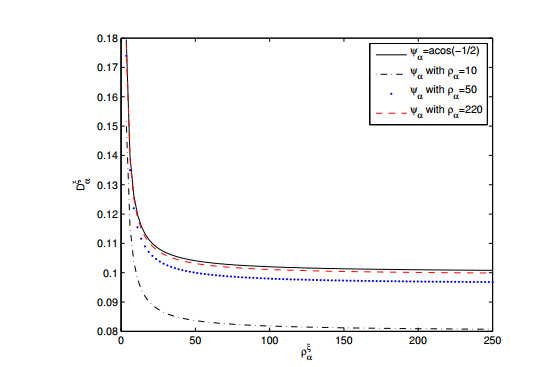
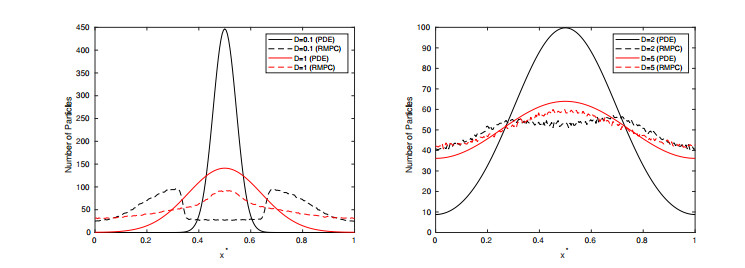
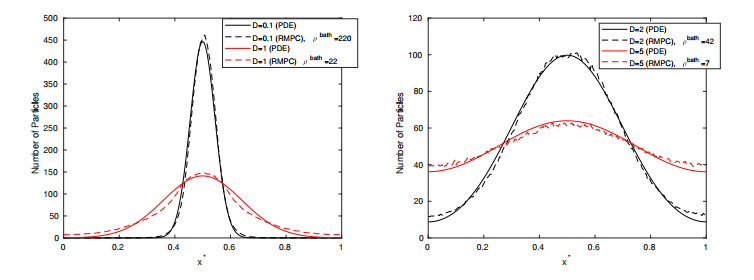
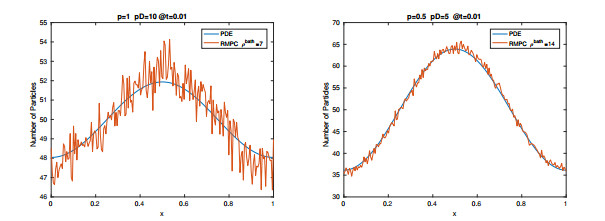
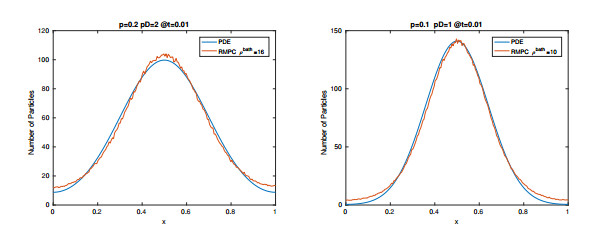
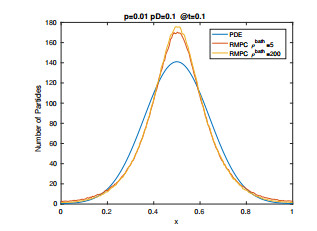
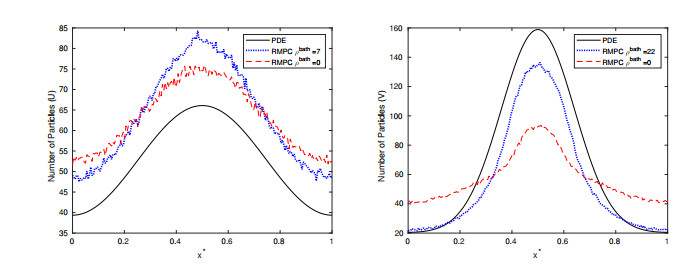
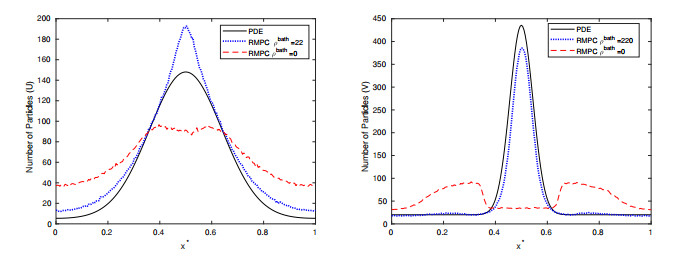
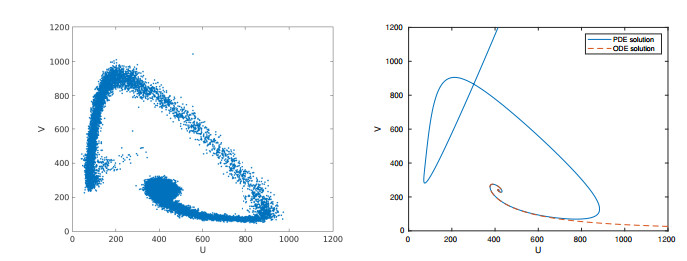
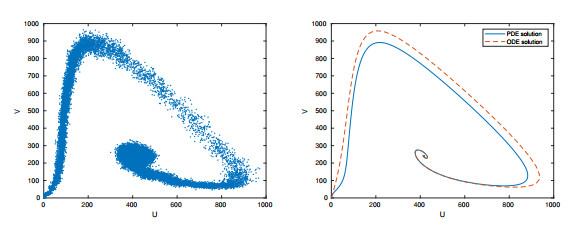
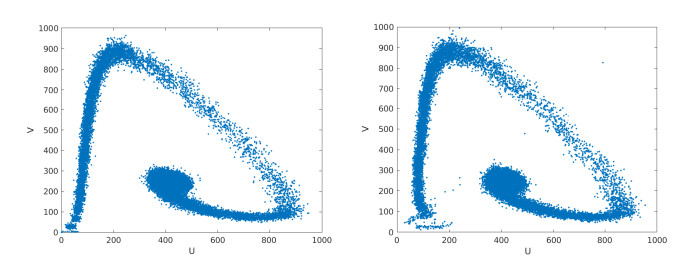
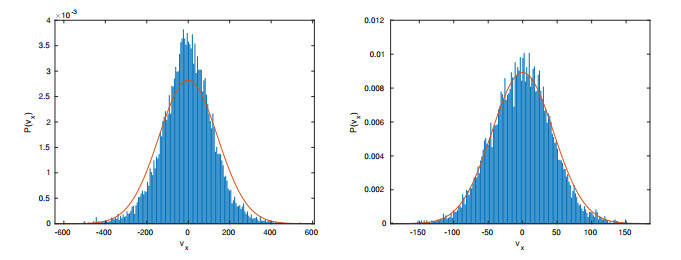
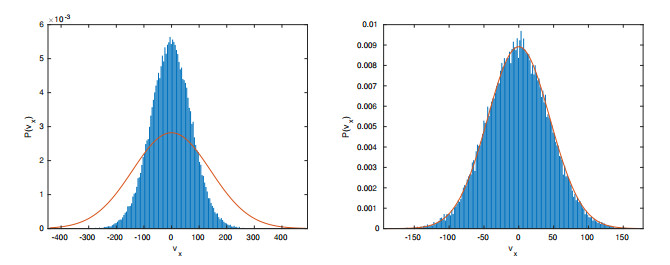
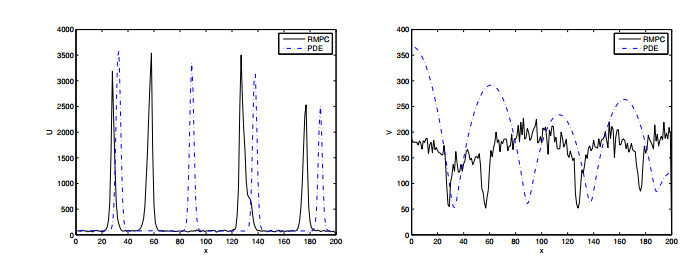
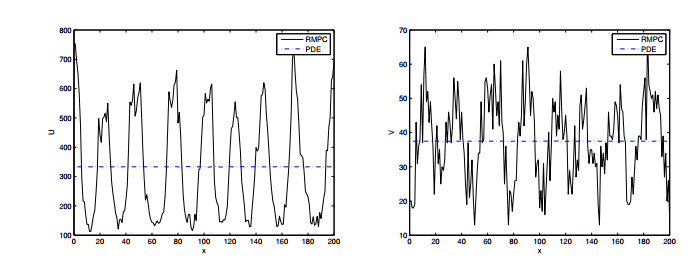


 DownLoad:
DownLoad: